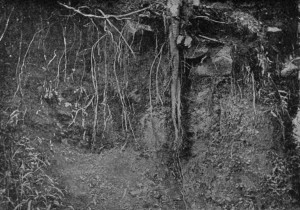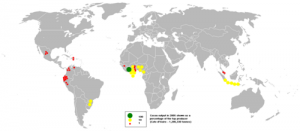SOIL
The chemical properties in the topsoil are most important for a plant that has a large number of roots for absorbing nutrients, like cacao. Cocoa can grow in soils with a pH in the range of 5.0-7.5. Cacao can be cultivated in both acid (assuming the nutrient content is high enough) and alkaline soil, but excessive acidity like a pH of 4 or lower or alkalinity , a pH of 8 or above, would not work out well. The soil should also have a high content of organic matter: 3.5% in the top 15 centimetres of soil. Organic matter in soil consists of decomposing animal and plant matter that are reservoirs of nutrients and water that reduce compaction and increase water filtration. The silicates that are essential in soil for cacao are nitrogen, potassium salts, phosphoric anhydride and lime.
WHERE & WHY
Cocoa is native to Mexico, Central America and northern South America (Colombia, Ecuador, Venezuela, Brazil, Guyana, Surinam and French Guiana). It has also been introduced as a crop plant into many tropical African and Asian countries.
In its natural habitat, cocoa grows in the understorey of evergreen tropical rain forest. It often grows in clumps along river banks, where the roots may be flooded for long periods of the year. Cocoa grows at low elevations, usually below 300 meters above sea level, in areas with 1,000 to 3,000 mm rainfall per year.
CLOSE UP ON THE IVORY COAST
After being introduced to cacao in the 18th century the Ivory Coast is now one of the main suppliers of cocoa to the whole world. The forest soils in the south tend to lose their fertility because of excessive leaching and turn into laterites, which contain iron oxide. The poorly drained, yellow, swampy soils, also found largely in the south remain more fertile because of their silica and clay minerals content.


